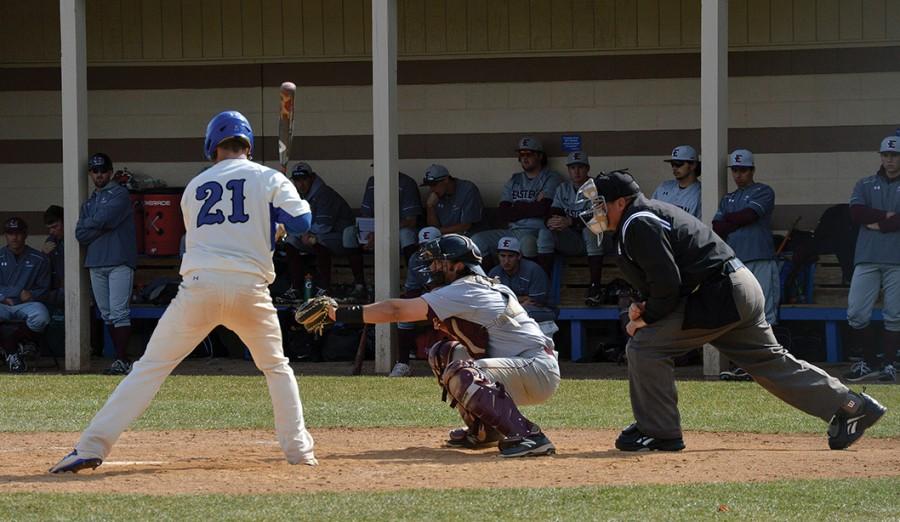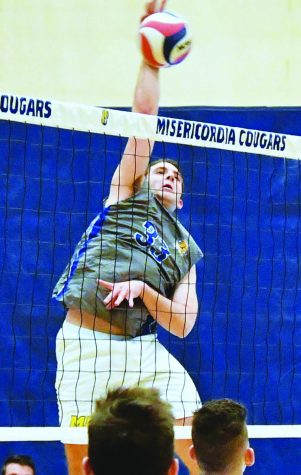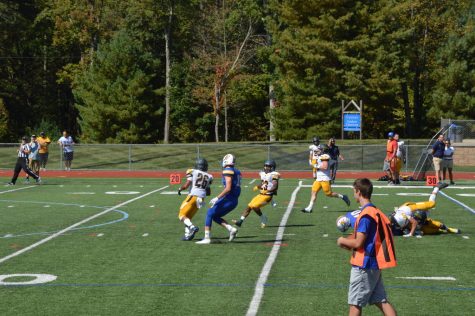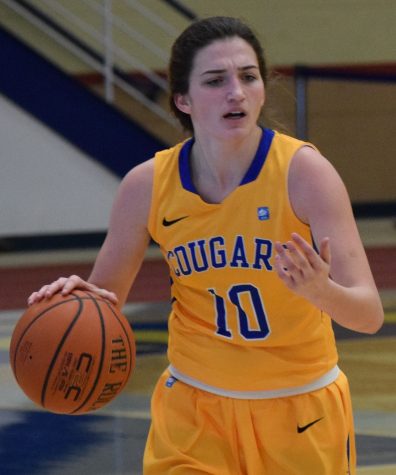Baseball Regulations Force Players to Tweak Game
Misericordia’s Mike Comerford (21) batting, at Tambur Field, Misericordia Univesity on Thursday, March 24, 2016 in Dallas, PA.
April 21, 2016
Baseball players and coaches are adjusting to new bat restrictions and ball changes.
The NCAA put restrictions on bats in 2011 to reduce the velocity hitters were generating when hitting a ball. The bat restrictions provided an advantage to pitchers due to the lack of pop in the new bats, resulting in another change in 2015. The NCAA altered baseballs by lowering the seams on a regulation-sized ball to allow players to hit the ball harder and farther than the less productive bats were allowing.
Pitching coach David Gargone said the new bat restrictions took the “bashball” element out of baseball.
“The balls used to fly out all over the park, and it was because the bats were a lot better than they are now and then I think the game changed too much [when the bats changed]. The offense was too impacted and the ball [design] was in response to the bats being changed,” said Gargone.
The lack of production with the restricted bats and high seam balls is demonstrated by the statistics. The average amount of home runs per game in college baseball from 2011 to 2014 was less than .5 in each of the four years. The average amount of home runs per game from 1980 to 2010 was never less than .66, according to the NCAA’s website.
There was also a significant drop in runs scored per game. The amount of runs scored per game was never less than 6.1 from 1980 to 2010. The amount of runs scored per game from 2011-2014 was less than 5.6 each of the four years.
This lack of production led to the NCAA changing the baseballs in order to even out the playing field.
“Baseball America” states that a regulation sized ball in 2014 was .048 inches in height, and in 2015, the altered ball was .031 inches. This .017-inch difference has caused the low-seam balls to travel an average distance of 20 feet farther than the high seam balls. The ball change is more relevant to players because it was instituted just last year.
Ryan Dorosh, four year starter and sports management major, said the low-seam balls have caused him to hold his pitches differently.
“With the low seam balls it seemed that everything would cut away from a right handed batter,” said Dorosh.
Dorosh also said on a two seam fastball, which is supposed to tail back toward a right handed batter. “[The two seam fastball] would cut as well,” said Dorosh.
Gargone agreed with Dorosh when he emphasized how the low-seam balls tend to move differently.
“I think that the biggest adjustment was pitchers not being able to control fastballs with the new baseballs because they all had the tendency to cut,” said Gargone.
Dorosh recalls that when the balls were altered, he and fellow pitchers complained about how difficult it was to control their pitches.
“Many of us got frustrated and it took a while for us to get the ball to do what we wanted it to do,” said Dorosh.
The change in baseballs has called for pitchers to make physical adjustments when throwing certain pitches. The fastballs tend to cut more, but according to Dorosh, that is not even the most difficult pitch to throw.
“The changeup for me is the hardest pitch to throw with the new baseballs. A changeup is supposed to tail away from a left handed batter. With the low seam balls, almost half of the changeups I throw cut towards a left handed batter.”
But Dorosh’s pitching strategy did not change. His philosophy has remained the same, too.
“I still pitch the same way. Just controlling my pitches is the only thing that I have had to do,” said Dorosh.
Coaches and players believe baseball is not only about strategy and physical skill, but also about being mentally inclined to play what has a reputation of being the hardest sport there is. The change in balls presented a mental test for pitchers throughout college baseball, they said.
Gargone explained how he and his players needed to understand that the balls were new and that they would become easier to throw in time.
“It was just getting over the block that pitchers are used to being able to manipulate the baseball the way they’ve done it for years, and then the new balls altered that, so it was just getting them to understand that we’ll get there and developing their confidence back,” said Gargone.
Despite the endless adjustments and “trial and error” approach towards the new baseballs, Dorosh experienced great success in the first year with low seam baseballs. Dorosh was 7-0 with a 2.47 ERA in 2015. He did not, however, attribute his success to the new baseballs.
“I think that being effective with the low seam balls is just controlling each pitch and figuring out what works well with each grip,” said the member of the 2016 pre-season All-American honorable mention team.
The changes in college baseball have required players and coaches to adjust accordingly. Any coach understands that in order to have a successful athletic program, his or her team needs to adjust to changes, and quickly. The baseball team has done just that, going 31-13 in the 2015 season.
Gargone believes the baseballs are not going to halt the team from achieving several goals. He has extremely high expectations for the team this season. Gargone feels that the team’s strengths make this the deepest team he has coached while at Misericordia.
“If there were going to be a year where we exceed expectations, get past winning the conference and get into a regional, I think this is the year we can make a World Series,” Gargone said.








